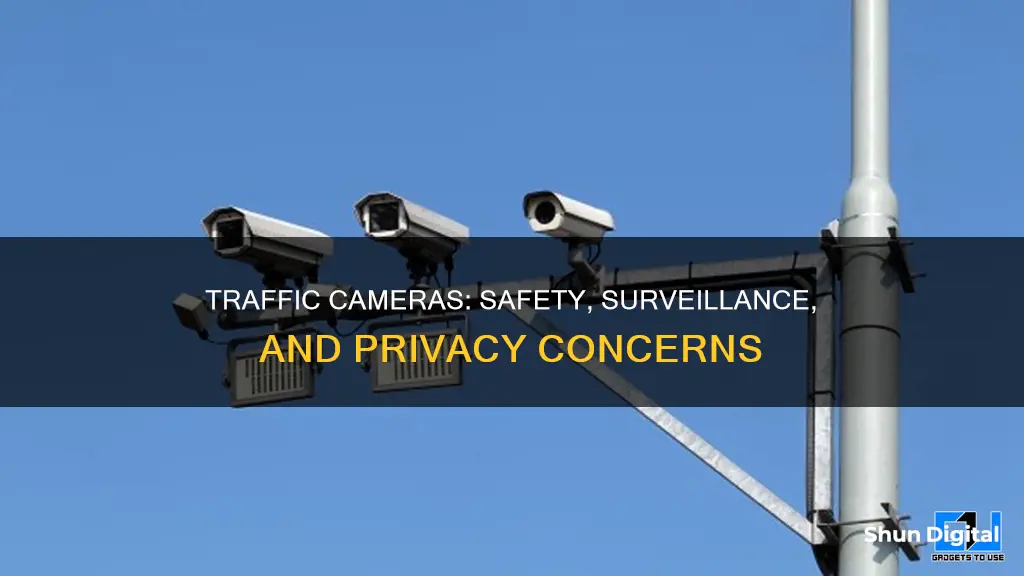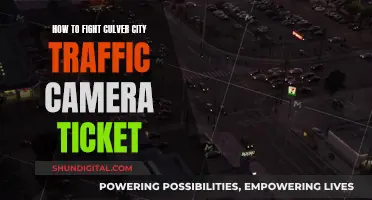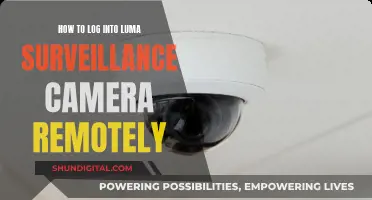
Traffic cameras are a common sight on roads and highways, but what are they for? Traffic cameras are used for a variety of purposes, including monitoring traffic flow, enforcing speed limits, and detecting traffic violations such as running red lights or speeding. These cameras can be classified into two main types: automated traffic enforcement cameras, which issue tickets and violations, and traffic sensor cameras, which monitor traffic speeds and conditions to help manage traffic flow and timing. While some people argue that traffic cameras invade privacy and are a form of government overreach, studies have shown that they can effectively reduce speeding and crashes, making roads safer for everyone.
| Characteristics | Values |
|---|---|
| Purpose | To observe and monitor traffic, enforce traffic rules, and improve road safety |
| Location | Major roads such as highways, freeways, expressways, and arterial roads; mounted on poles, masts, or traffic lights |
| Technology | Digital video and image capture, radar and laser, automatic number-plate recognition |
| Benefits | Reduce accidents and save lives, improve safety, supplement law enforcement efforts, modify driver behaviour |
| Concerns | Privacy invasion, due process violations, unfair penalties, government budget filling |
| Legality | Ruled legal and constitutional by multiple U.S. Circuit Courts of Appeals |
What You'll Learn

To monitor traffic patterns and signal violations
Traffic cameras are an essential part of public and private transportation and logistics departments, and they play a crucial role in improving traffic flow and road safety. One of their primary functions is to monitor traffic patterns and signal violations.
Traffic cameras are typically placed at strategic locations, such as complex intersections, roads with heavy congestion, or areas with extreme weather conditions. These cameras are often mounted on poles, bridges, or other structures, providing a comprehensive view of the traffic flow and conditions. The footage from these cameras is transmitted in real time to a control center, where traffic engineers and law enforcement personnel can monitor traffic patterns, detect accidents, and take appropriate action.
One of the key advantages of traffic cameras is their ability to help enforce traffic laws and reduce violations. For example, red-light cameras are designed to capture images or videos of vehicles that run red lights at intersections. These cameras are usually placed at busy junctions and are equipped with sensors to detect when a vehicle enters an intersection on a red light. This evidence can then be used to issue tickets to offending motorists, encouraging them to follow traffic laws and improve road safety.
In addition to red-light cameras, speed cameras are also used to monitor traffic patterns and enforce speed limits. These cameras are typically placed on less populated back roads or in residential areas and are designed to detect when a vehicle exceeds the speed limit. Like red-light cameras, speed cameras can capture images or videos as evidence and automatically issue speeding tickets to offenders.
Traffic cameras have been shown to be effective in reducing accidents and improving road safety. Studies have found that intersections equipped with red-light cameras experience a decrease in fatal car accidents and red-light violations. Additionally, traffic cameras can help reduce congestion by providing real-time traffic data, allowing motorists to plan their routes and avoid congested areas.
Overall, traffic cameras play a vital role in monitoring traffic patterns and signal violations, enhancing road safety, and improving traffic flow. By providing valuable data and evidence of violations, these cameras help law enforcement agencies and transportation authorities make informed decisions to ensure the safety and efficiency of our road networks.
Unlocking Galaxy S7L8 Camera Modes: A Step-by-Step Guide
You may want to see also

To improve road safety
Traffic cameras are an increasingly common feature on roads across the world, and they play a crucial role in improving road safety. They are typically installed on major roads such as highways, freeways, expressways, and arterial roads.
One of the primary functions of traffic cameras is to monitor traffic patterns and road conditions. These cameras are often connected to optical fibres buried alongside or under the road, providing a clear view of the entire road or intersection. The footage from these cameras can be accessed in real time by monitoring centres, which can then dispatch assistance in the event of a collision or other disruptive incidents. This is especially valuable in tunnels, where safety equipment can be activated remotely based on the camera footage.
Another way that traffic cameras improve road safety is through the enforcement of traffic rules. For example, red-light cameras capture photographs and videos of vehicles that run red lights, providing crucial evidence for issuing tickets. Speed cameras also monitor and enforce speed limits, capturing images of vehicles that exceed the speed limit. These cameras can be fixed or mobile, with the latter being set up by law enforcement and moved as needed.
In addition to red-light and speed cameras, there are also stop sign cameras, which use radar technology to detect if vehicles stop, roll through, or drive past a stop sign. School bus cameras are another type of auto-enforcer, capturing photographs and videos of vehicles that illegally pass school buses, thus helping to ensure the safety of children.
By enforcing traffic rules, modifying driver behaviour, and providing timely assistance in the event of accidents, traffic cameras play a crucial role in improving road safety.
Beating Traffic Cameras: Tips to Avoid Getting Snapped
You may want to see also

To reduce red-light running and collisions
Traffic cameras are an effective way to reduce red-light running and collisions. They are an essential tool for improving road safety and modifying driver behaviour.
Red-light cameras are specifically designed to catch drivers who run red lights. When a vehicle enters an intersection after the signal light has turned red, sensors installed in the road trigger the camera to capture images or video of the vehicle, along with its license plate, as evidence of the violation. The use of red-light cameras has been shown to significantly reduce the number of drivers running red lights. For example, a study in Virginia found a 67% reduction in red-light running after the introduction of cameras.
While the use of traffic cameras can lead to a decrease in certain types of accidents, such as "T-bone" or angle collisions, there may be an increase in other types, such as rear-end accidents, as drivers may be more likely to stop suddenly to avoid a fine. However, rear-end accidents tend to be less severe, resulting in a net positive effect on road safety.
In addition to reducing red-light running, traffic cameras can also help to curb speeding. Speed cameras, for instance, monitor and enforce speed limits, particularly in less populated areas like back roads or residential areas. They can be fixed, mounted on poles, or mobile, set up by law enforcement and easily moved.
The presence of traffic cameras can also help reduce instances of police officer bias during traffic stops, providing an unbiased tool for monitoring vehicles continuously. This can lead to improved safety, especially in areas with a high volume of traffic or near schools, where modifying driver behaviour is crucial.
While the use of traffic cameras has been controversial, with some arguing that they invade privacy or are solely for generating revenue, they have been ruled legal and constitutional by multiple U.S. Circuit Courts of Appeals. The primary purpose of traffic cameras is to enhance road safety, reduce collisions, and save lives.
Inverting Your Computer Camera: A Simple Guide
You may want to see also

To track locations of vehicles and drivers
Traffic cameras are often used to track the locations of vehicles and drivers. Automated Number Plate Recognition (ANPR) cameras are a key tool in this regard, as they can automatically read and analyse number plates from a vehicle. This technology can be used by law enforcement to pull up vehicle and driver information from government databases.
ANPR cameras can be either fixed or mobile. Fixed cameras are mounted on poles or other structures, while mobile cameras are mounted on police vehicles. These cameras are often used to track the whereabouts of specific vehicles and drivers, which has raised concerns about government overreach and the potential for mass surveillance.
In addition to ANPR cameras, other types of traffic cameras can also play a role in tracking vehicles and drivers. For example, red-light cameras capture images of vehicles that run red lights, and speed cameras monitor and enforce speed limits. These cameras are usually placed in high-risk areas to prevent speeding and red-light offences.
The use of these traffic cameras for tracking purposes can be controversial, with some arguing that it invades privacy and enables government overreach. However, supporters argue that it is an effective tool for law enforcement and can help improve road safety.
Surveillance Cameras in Parking Lots: Are They Watching?
You may want to see also

To monitor traffic and dispatch in the event of a collision
Traffic cameras are an essential component of a city's transportation system, providing real-time monitoring of traffic flow and road safety. They are strategically placed along major roads, highways, and intersections to capture a comprehensive view of traffic conditions. These cameras are connected to a monitoring center, where personnel can observe the footage and act as dispatchers in the event of a collision or other incidents.
Traffic cameras play a crucial role in reducing accidents and improving road safety. They can detect and enforce traffic violations, such as speeding, red-light running, and unauthorized use of lanes. This helps deter people from breaking traffic rules and encourages compliance, ultimately reducing the number of accidents and saving lives. The presence of these cameras can make drivers more alert and cautious, leading to improved road safety for both motorists and pedestrians.
In addition to their safety benefits, traffic cameras also aid in traffic management. By monitoring traffic flow, transportation officials can make informed decisions to optimize traffic signal timing and routing, reducing congestion and improving traffic flow. This is especially valuable in tunnels, where remote activation of safety equipment based on camera footage becomes crucial.
The footage captured by traffic cameras also serves as valuable evidence in the event of accidents or crimes. It helps authorities determine liability and understand the circumstances leading to the incident. This can lead to improved road planning and the development of new traffic management strategies to enhance safety further.
Furthermore, traffic cameras can be integrated with other systems, such as parking lot surveillance cameras, to create a robust security network for the city. This integration enhances the overall safety of the transportation system and helps law enforcement personnel better monitor and manage potential incidents.
Overall, traffic cameras play a critical role in monitoring traffic, improving road safety, and facilitating efficient traffic management. They are an essential tool for cities to ensure the well-being of motorists, pedestrians, and commuters. By leveraging technology, cities can make informed decisions and take appropriate actions to create a safer and more efficient transportation environment for all.
Charging the FinePix XP120: A Step-by-Step Guide
You may want to see also
Frequently asked questions
Traffic cameras are used to monitor and enforce compliance with road safety rules, such as speed limits, red lights, and bus lanes. They can also be used to detect instances of unauthorised use of toll booths, congestion charge areas, and bus lanes, as well as for recording vehicles inside these areas.
Traffic cameras have been shown to reduce dangerous driving behaviour, such as speeding and running red lights. A worldwide review of studies found that speed cameras led to an 11% to 44% reduction in fatal and serious injury crashes.
Traffic cameras are usually mounted beside or over a road, or installed in an enforcement vehicle. They may be fixed or mobile, and can use a range of technologies, such as Doppler radar, LIDAR, or automatic number-plate recognition.







